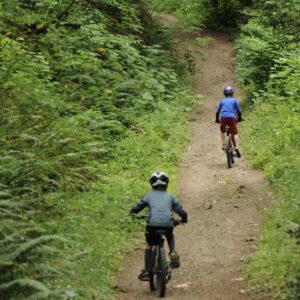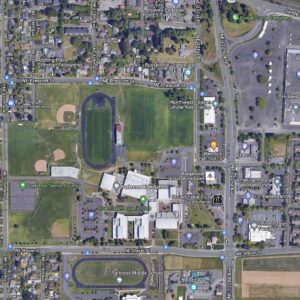Over the next few weeks we’ll be bringing you bits and pieces of Portland’s forthcoming Bicycle Master Plan for 2030. The plan is being updated for the first time since 1995 and it will contain many important bicycle policy guidelines (and more) that will eventually be folded into Portland’s Transportation System Plan.
The plan is slated for public comment very soon and it will likely be in front of City Council toward the end of October. I’ve been reading through an internal rough draft and thought I’d share a bit of it with you.
Part One of the plan lays out PBOT’s vision of “A World-Class Bicycling City”. In addition to making the case for why the city should invest in bicycling, it explains the process of updating the plan, describes the latest thinking on “the nature of bicycling” and it explains PBOT’s “framework for bicycling policy”.
Part One is also a glimpse into the City’s latest thinking about bicycles. Here’s an excerpt from a section titled, “The road to Portland’s future.”
“The road to Portland’s future will include many, many bicycles…. The cost may be modest compared to the dizzying costs of other transportation investments, but the benefits will be enormous.
We have the opportunity to make Portland an even better place. Bicycle transportation is an important part of our future.”
While much of this is prosaic, what’s exciting about the bicycle master plan is how it leaves no stone unturned in telling the bicycle story. Take, for instance, the section on “The nature of bicycling”.
This section discusses larger context issues like how bicycles requires so much less space than cars (that can then be used for parks, commerce, and so on) and then there’s this:
“The bicycle is also liberating and provides a psychological freedom that motorists and transit riders do not enjoy. The psychic benefit of autonomous travel comes with the physiological benefits from cycling exercise.”
Now that’s not something I think you’d expect in a wonky planning document.
Other interesting bits in Part One include a section on bicycles as vehicles. This section explains in detail how bicycles are different than cars. What PBOT, and the committee they’ve formed to help write the plan, are doing is to thoroughly explain their rationale behind wanting to build the next generation of bikeway infrastructure. For instance,
“Bicycles are powered by muscle, are unstable at slow speeds and have hardly any suspension. Any bicycle-friendly road design should keep these properties in mind in order to keep energy losses to a minimum.”
Part One also includes a chapter on how the City wants to approach bicycle policy. The big item in this section is the “Overarching Policy” statement about bicycle planning. This key statement will become an important rallying point for bike-related planning decisions. The overarching policy in the current bicycle master plan is:
“Make the bicycle an integral part of daily life in Portland, particularly for trips of less than five miles, by implementing a bikeway network, providing end-of-trip facilities, improving bicycle/transit integration, encouraging bicycle use, and making bicycling safer.”
In the draft plan, the new statement is much shorter and sweeter:
“Create conditions that make bicycling more attractive than driving for trips of three miles or less.”
I think that’s a big improvement. More direct and more concise. I also like how it zeroes in on making bikes a better option than cars — which will be essential in reaching the bike usage numbers PBOT hopes for in the future.
Part Two of the plan is titled, “The Bicycle Network”. We’ll delve into that in the next few days.






Thanks for reading.
BikePortland has served this community with independent community journalism since 2005. We rely on subscriptions from readers like you to survive. Your financial support is vital in keeping this valuable resource alive and well.
Please subscribe today to strengthen and expand our work.
I have seen this proposed redraft of policy 6.12 before, and I wonder whether it means not only “improving” conditions for bicycling but also making things less amenable for motoring (removing onstreet parking, lowering speed limits, putting calming devices everywhere, etc.)
Looks to me like reflection-speak. PBOT see’s lots of bicycles, and hears that riders want more(paths, bike lanes, wider lanes)..etc. So tell them you’re gonna get it, Yea!. Grandma always said..seeing is believing.
“Now that’s not something I think you’d expect in a wonky planning document.”
No kidding. And I bet it gets removed long before the document becomes final. The idea that “autonomous travel” might be a good thing is anathema to most planners and bureaucrats. In their world, you should only be allowed to go when and where the train goes, and they decide where the train goes.
@are #1 — you hit the nail on the head. We need to make some tough choices that will shift amenities from cars to cyclists and pedestrians. We’ve certainly given up enough space and money to cars, there is a strong case in Portland for more backpedaling.
I’d love to see Portland remove parking for more bike-only lanes and to improve our sight triangles. The latter actually benefits all road users.
I would love for the master plan to include maintenance of existing facilities. Overgrown bushes crowd cyclists into auto lanes. Railroad tracks beat up pavement and widen their channels. Culverts and catch basins overflow and load pathways with slippery mud. The policy now is to create new facilities then let then ignore them as they degrade.
Bob_M,
You’ll be happy to know that PBOT is already thinking about how to maintain the network. Geller said in a meeting today that in the master plan will be wording to create a special pot of funds set-aside to do maintenance on the network (but only after annual bike spending hits $10 million).
PBOT has even talked about having a dedicated bikeway network maintenance crew.
but yeah, I hear your concerns and I agree that maintenance of bike facilities is key and is overlooked… but compared to other cities i think Portland is doing pretty well.
In their world, you should only be allowed to go when and where the train goes, and they decide where the train goes.
Yet, the statement you are criticizing was written by planners, and directly contradicts your “analysis.”
I agree though, that attempting to analyze the state of mind of travelers, and assuming cyclists are inherently happier, is a bit happy-happy-joy-joy for a policy document.
When I ride the bus, the only thing I have to worry about is the book I’m reading. When I’m on my bike, I worry a lot about getting killed by the bus I’m not on, or by the guy in an F-350 who is blasting by me 2 feet away at 45 mph.
A couple weeks ago, me and my car exercised our freedom and rented a cement mixer to pour a patio in my back yard. Try lugging that and 1,200 pounds of concrete on a bike.
psychological freedom that motorists and transit riders do not enjoy.
is completely subjective, biased, and void of any demonstrable fact. I bet it doesn’t make it through review either.
I’ve heard that in many places in Europe (particularly the Netherlands) the infrastructure for bikes has reached the point at which it is much, much faster to get to destinations by bike than by car. When you reach this inversion of convenience, that is when people will begin to adopt bicycling in massive numbers.
Likewise when it comes to public transit – create bus-only lanes, express trains, etc. and people will flock to it in droves. The incentives are all about convenience, and cars are still the epitome of that here.
#8 hit the nail on the head. Believe me, I’m all for making Portland even more bicycle friendly, but the key will be when the city decides to make cycling more important than driving. Not every road has to be bike-first in priority, but if Portland make it easier and quicker to bike from A to B than drive, then I think the scales will begin to tip. Reduce car parking, increase bike parking, create thoroughfares from one section of the city to another than prioritize cycling (adjust traffic light timing, reduce/remove stop signs, disallow cars on certain streets, etc.).
re comment 4 and sight triangles. couldn’t agree with you more. ORS 811.550 already forbids parking within 20 feet of a marked pedestrian crosswalk or within 30 feet of an unmarked corner crosswalk. but there is less than zero enforcement.
I agree w/#4 and #10 on sight triangles. In Seattle, many stop signs have an additional sign “no parking within 30 feet.” Back when I lived there, it seemed like a nice revenue generator for the city, especially around the UW.
I’m mostly interested in biking for the much touted “psycic benefit”. next time i get doored or the dreaded right hook I’m going to bust out my newly gifted powers and lazer blast the offending gas burner, pew pew!!!
oh wait, that’s not what the plan meant? darn.
I wasn’t aware of the 20ft near a crosswalk law, I’ll have to look that up.
There is a law that states any vehicle over 6ft tall cannot park within 50 FEET of an intersection. Again, it’s only enforced when they receive complaints. In other words, it’s not really a law!